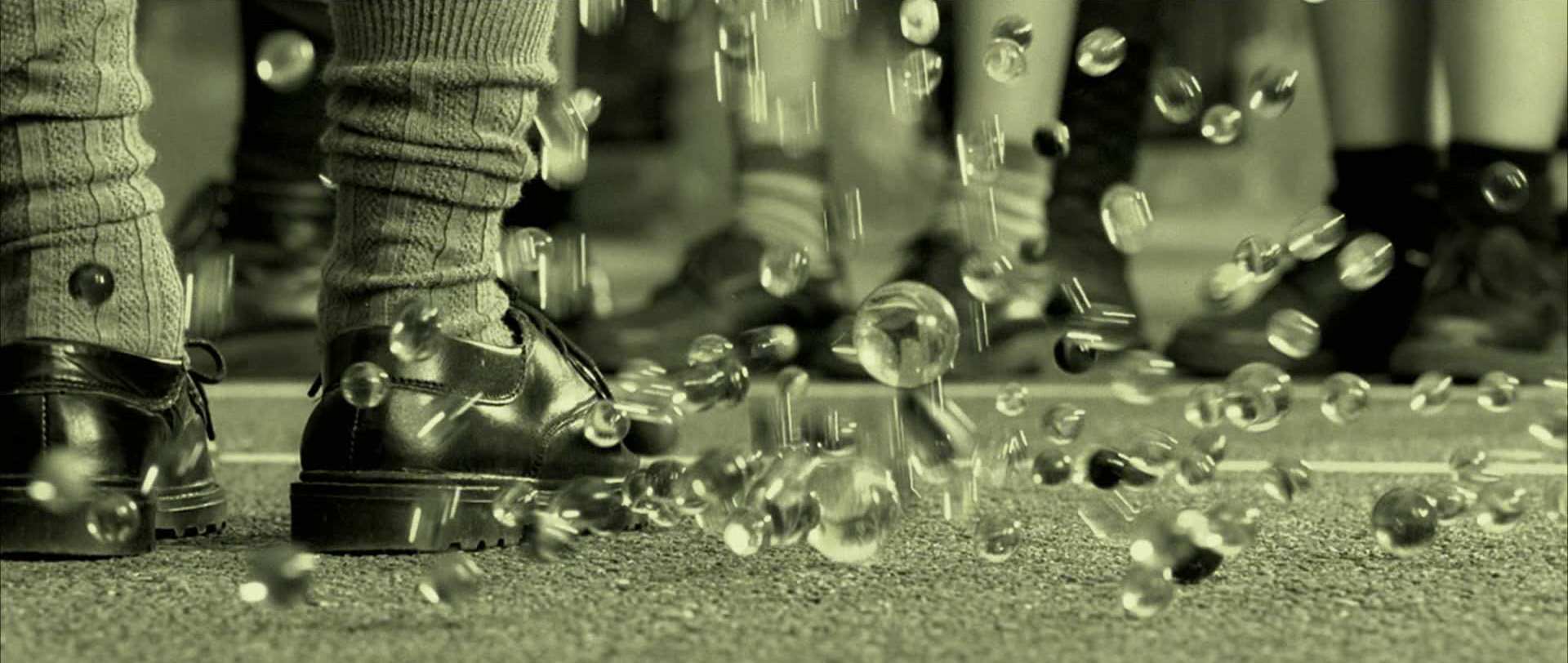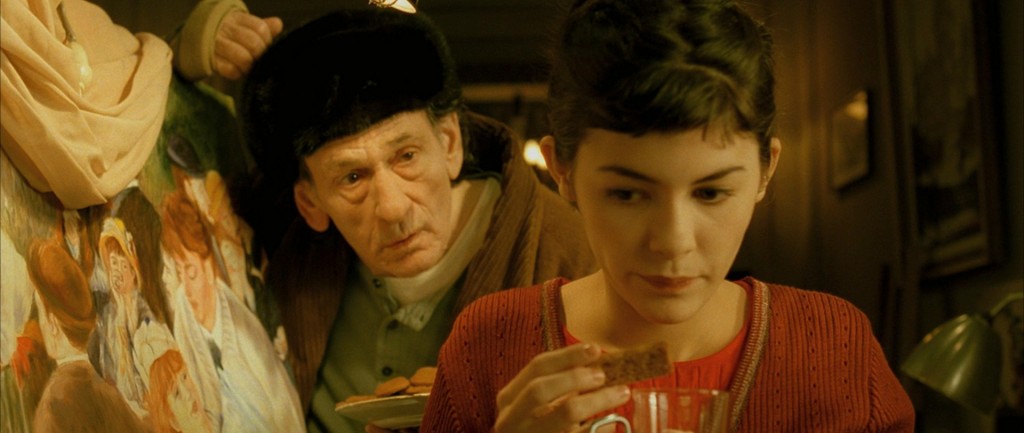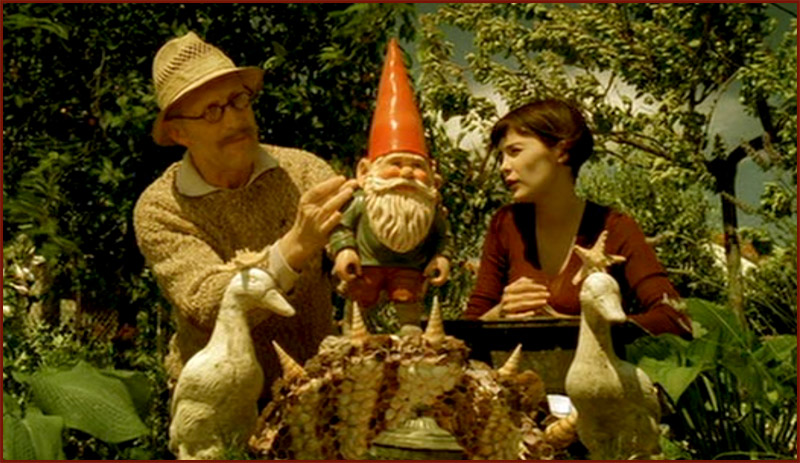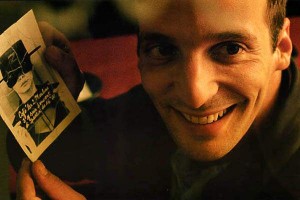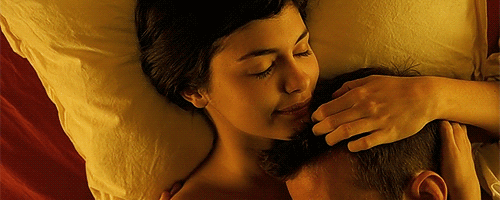I believe that this is a hugely important show. Whenever a population is under-represented in popular culture, the stakes are really high for how their characters are portrayed. So while Sam can only be one representation of someone on the spectrum, I think the show does a very good job at making one extremely important point: autism brings with it many gifts, and they should absolutely be understood and honored.
I think it was a great writing move to give us a bunch of information about Sam by allowing us to hear what he says both in therapy and to himself in thought. Therapy is intended for the express purpose of allowing someone to be exactly who they are. That makes it a great place for us to gain insight into a character, and I often wish writers would take advantage of this more often. But while we do get to learn a lot about Sam in this way, what actually happens in Sam’s therapy sessions is the stuff of my actual nightmares.
If the aim was to show what it’s like to have an empathic break between therapist and client, I understand. That most definitely happens sometimes in therapy, and it can have an enormous impact on our lives. However, I worry that much of the audience will walk away without knowing that what they just saw was a very unskilled therapist. It’s a bummer and a missed opportunity, because solid therapists are also a population that’s grossly under-represented in our entertainment. But beyond just my own disappointment as a professional, I worry that any lack of insight into Julia’s mistakes will work against the message of the show. So let’s unpack a whole bunch of moments.
S1E1
We’re introduced to Sam while he’s in session with his therapist, Julia. After a rich and meaningful sharing on Sam’s part, the first thing we hear from Julia is a misattuned, “Great. Well time’s almost up. Good session today, Sam.” How confusing for us. What was good? Is she addressing one of the many things he just said? Which one? And by the way, a pretty safe test for realistic writing about a therapist is whether or not they have the therapist comment on how well the session went, state that the time is up, or disclose information about themselves with no awareness of the impact.
When Sam comments that he can see Julia’s bra and that it’s purple, she looks surprised and uncomfortable. She tucks in her bra strap, raises her eyebrows for a moment, and says nothing. I was ready to forgive this until we find out that she specializes in autism. She should be used to that sort of blunt honesty, and she should definitely be comfortable with it, or willing to process it. If she doesn’t want Sam to comment in such a way, she can tell him that and they can work it out together. That’s kick ass practice for communication in relationships, which is a huge part of anyone’s therapy. Personally, I really enjoy those moments. One of my favorite things about being a therapist is that it keeps me on my toes about what I’m bringing into the room. Sometimes it’s an emotion; sometimes it’s a wardrobe malfunction. Isn’t she kind of amused by that moment? Ok, but so now we know that Julia isn’t all that insightful into how she impacts her clients and maybe she’s not so comfortable with herself either. Was that on purpose?
Then she dives into asking if he’d be willing to donate his brain to research after he dies. While that is theoretically acceptable, she doesn’t process with him the impact of being asked such a huge question. We find out later that he doesn’t care, but it was her ethical responsibility to ask. Autistic folk get a wealth of disparaging comments about their brains and they also get a lot of odd fascination about them. Sam could easily have felt like Julia was more fascinated by than dedicated to him. After all, she seemingly ignored most of what he just said.
Clearly the interaction between them was intended primarily to plant the seed of awareness that it’s completely possible for Sam to date, which is the premise of the show. She did well to let him know that it’s not only doable, but is being done by others, and that it’s his choice. We could have gotten that without the mess if, at the end of his sentence, she’d immediately inquired about his statement that he can’t have a girlfriend, and then planted that seed. Perhaps she’d even get to learn where that a big part of that belief came from, and she’d have been more prepared for the protest of Sam’s mother (Elsa) later on. A therapist specializing in autism, with Sam as her client, should also know not to drop a colloquialism on him about a new topic. “You just have to get out there,” is pretty meaningless for anyone hearing it for the first time, let alone someone who just said that he can’t always infer meaning. I’m glad that Sam asked where, and I wish we knew how she answered, but she didn’t even seem ready to explain. Explaining slang and colloquialisms is a swell part of therapy with autistic folk. It makes you realize how often we make assumptions in our communications. It’s a barrier to understanding that is highlighted in communication with a lot of autistic people, but it affects absolutely everyone. One of my earliest supervisors would constantly remind us to ensure that we understood our clients’ definition of non-literal words and phrases. This negotiation of meaning is some of the richest work we do in therapy, as it’s an excellent vehicle for self-understanding and interpersonal connection.
Oof, we’re only at minute two of this episode and my word count is over 1,000! You might want to refresh your beverage.
So, when Elsa goes to speak with Julia regarding her concerns about Sam and dating, I went from worried to very worried. We overhear Julia teaching an introductory course on the autism spectrum, and she offers an example of “persistent preoccupations” from one of her clients. “I have a client who came up with 95 different ways to cook an egg,” she says. We can assume that she got permission to disclose this, but I’m still left very concerned about the way she said it. It seemed to have an undertone of, “Isn’t that crazy?” when I’d really like to hear an autism specialist have the sentiment, “Isn’t that wonderful?” behind their words. Is it not wonderful? The next time you wonder who came up with some incredibly unique and intricate way of doing something, allow yourself to consider that the answer might very well be an autistic person. The way that Julia spoke to her class so stood out to me that I assumed Elsa was about to lay into her for it and find a new therapist for Sam. But ok, the intention was not to make a comment on the availability of good therapists, but for us to see that Elsa’s struggling with protectiveness over Sam.
On to the conversation between Elsa and Julia, which may have been a problem in and of itself. We know at this point that Sam is 18, so Julia might not have needed signed consent from Sam’s parents and she therefore may not be permitted disclose anything about their work together. But we can assume that, as Sam’s in high school, his parents are probably paying for his sessions and thus would have signed the consent form. Were that the case, she still should have checked with Sam because he’s more than mature enough to make that decision on his own. This is extra important when a teenage client is about to embark on something as adult as dating. As Julia mentioned, it can be really hard on parents, so it’s typical to ready everyone before these unannounced visits occur. What Julia did handle ok here was to offer support to Elsa through a referral. I liked the way she said, too. It really is about having a space that’s just for you, and that’s why it can be so great. But her suggestion would have gone a lot better if she’d begun by meeting Elsa where she was instead of trying to fix it through a statement of what commonly happens. It’s pretty much Therapy 101 to begin an interaction with someone by ensuring that you understand where they’re coming from. It’s then that they can hear you in return. No one likes a, “Yeah, but…”
The second of Sam’s sessions that we see is one of the ones I find the most upsetting. Sam wants to go over his tactics for dating, and again Julia seems surprised and uncomfortable by the content. When he hands her his notebook and she spies the phrase “insults = chick on dick,” she’s certainly right to bookmark it to come back to later, but she seems so unsettled. Knowing Sam as we do, it makes sense that he might not have a red flag go up for him about this particular piece of dating advice. When most social tactics aren’t very relatable, it can be easy for them to be indistinguishable from each other. The only part of this I don’t quite buy is that Sam would trust a non-scientific source. But that’s mostly dealt with by his commentary on how unscientific dating seems to be in the first place.
The worst part of this session is the “smile training.” When Julia inquires about how Sam scared a girl away, he demonstrates for her the smile he used. Again, she looks surprised. I suppose it could be that she’s managed to never meet an autistic person who’s been told to mimic common facial expressions, but it would very likely have been included in her education and training. But even if we extend her all the possible flexibility here, her approach to supporting Sam with his smile is just plain offensive. She calls him creepy, for goodness’ sake. And then she goes on to walk him through what to do with his mouth, and offers her own very unnatural example of intermittent eye contact. No one effectively learns how to smile by being coached through how to hold their face. It’s that sort of “Show your teeth, honey” advice that results in a rash of second graders bearing their teeth like they’re at the dentist. A smile comes from the inside out. And it’s not as though Sam never smiles. We’ve seen him smile already at this point in the show. If he truly wishes to practice, Julia can support him by pointing out when he’s smiling about something so that he can really notice the sensation. But even this walks a fine line. There are a whole bunch of ways that people who struggle with social communication can find a way to express themselves and connect. Faking a smile can be disingenuous at best, but at worst, it sends a message to the client that they need to be something other than themselves in order to be attractive. Fuck that noise. If Sam genuinely wants to learn how to smile more spontaneously, he can practice by tapping into an emotion that makes him smile. That’s what’s actually happening when we smile at each other. Impulse, signals to the muscles, and bam: natural smile.
This same principal goes for all supportive approaches, especially when it comes to dating. There are no tactics; there are only ways to find authentic expression and connection. Any good dating advice isn’t advice at all, but rather information on interpersonal dynamics. From there, it’s up to each of us to find our place within a social setting. The factors that are at play in a dating scenario are often relatable to just about everyone. That initial smile, for instance, communicates something specific. It’s generally something like interest, pleasure, and safety. Everyone is out to feel comfortable being themselves, and to experience intimacy. Beginning with that awareness helpfully informs us as we figure out how to do that, because intention acts as a guide.
S1E2
The first session we see in this episode will make an excellent tutorial called “What Not to Do With Self-Disclosure.” Sam realizes that he’s attracted to Julia, so he begins to ask her personal questions. If you’ve ever asked your therapist a personal question, you probably know what to expect next. (S)he should invite you to explore what exactly you’re asking to learn, why, and what it might be like to hear the different possible answers. That can be an annoyingly long process for the client, but it’s some of the most important work a therapist and client can do on their relationship. This is largely because it’s excellent practice for all the rest of our relationships. Other people affect us, and can really understand how and why when we get to have a process with it. If you’ve had your therapist actually answer a personal question, you might know what a big impact even a little bit of information can have. In Sam’s case, when he asks Julia what her favorite winter sports are, he learns in one fell and unprocessed swoop that she has a boyfriend. Mind you, this is after three other personal questions that she answered with a shortage of thought but a wealth of exasperation. If she’d gotten interested in his questions, she could have helped him to understand their professional boundaries, and to process his feelings about them. She wouldn’t even have had to answer his questions in order to do this, because nearly all the important pieces are in exploring the whys and what-ifs. That is exactly why it’s so important to not immediately answer a client’s questions. Once you do, you’re necessarily moved on to processing the impact. But Julia didn’t do that either.
Fortunately, Sam gets a lot of what Julia ought to have provided in that session from conversations with his dad. He knows how to navigate literalness in communication, which we see when he asks Sam, “Do want to talk about it? [Sam says yes] Now?” Doug’s approach to Sam is pretty darn lovely in general, and I love that we get to witness some really sweet and important moments between them. Not only does he fully support Sam’s desire to date, he does a lot to encourage Sam to be himself and to focus not on Julia, but on “girls who are going to like you, too.” It’s important to note here that it isn’t actually a conflict of interest for Sam to have romantic feelings for Julia, even if he tells her about them. It’s very common and perfectly healthy to develop romantic feelings for your therapist. I mean, what could be more appealing than a person who allows you to be completely yourself when you’re around them? Good therapy means experiencing a lot of intimacy and connection. Even without unconditional positive regard coming from Julia, Sam gets to have a lot of sustained attention from a beautiful and intelligent woman. That alone could be pretty appealing. But what else might he like about her? Why? Where else might he able to have those feelings? When you explore these aspects of attraction, you can learn a whole lot about yourself, what you need, and how to get it.
We can give Julia a quick break while we look at Elsa’s group therapy experience. There aren’t a whole lot of red flags that go up for me with this until Doug joins in later. I want to include it, because whenever a client seems to get “dropped” in a therapy setting, I’m compelled to let people know that that shouldn’t happen. Being dropped is when you express something and you either can’t tell if it was heard or don’t know what impact it had on the listener. When Elsa finishes sharing something very vulnerable, she’s responded to with an automatic round of applause. I suppose this could be a rule in some groups, especially if they are support rather than process-focused. But know that a support group therapist would at least be giving Elsa a warm and supportive look, or she’d approach her after group to ensure that she’s getting enough one on one support (as Julia suggested).
S1E3
It was useful that Julia immediately supported Sam in his desire to attend to his wardrobe. As before, it was what seemed to be behind her words that I found troublesome. It struck me as pretty infantilizing. When he asked why clothes seem to matter to girls, her feedback was fair, but she lost me with her manner of response when he made a comparison to iguanas flaring their dewlaps. She said, “Exactly like that,” and then frowned and murmured, “I think.” If she isn’t sure, she shouldn’t have said so, or she should have explained her backpedaling. Therapeutically, it’s not a huge deal, because the comparison he made was indeed a helpful one. Clothes can be a social cue that others are attracted to or not. Her advice to “pick something that feels like you” is so-so, but she said, “just pick something that feels like you,” as though that’s a straightforward task. Just like with colloquialisms, these things sometimes need to be explained. And while Sam’s mom has been picking his clothes, we learned that Sam has had a role in that, because she buys him shirts that he finds physically comfortable. This is very common for people on the spectrum, and it’s a very important desire to honor. Frankly, couldn’t a lot of people do with putting a heavier focus on comfort than style? An uncomfortable piece of clothing can affect your whole day. Without attending to all these important aspects of choosing one’s clothes, Julia’s attempt at cheerleading with her “stylish dude” comment is pretty unhelpful. Had this gone differently, maybe Sam could have avoided that future baloney with the leather jacket.
S1E4
The main concept I’d like to focus on here is the phrase “higher functioning.” For many years now, our field has been trying to do away with that term and its counterpart, “lower functioning.” Like any of the terms one can find in the DSM, the aim is to point to an experience. I get that. What gets sticky is the suggestion that something like being nonverbal is somehow a lower level of functioning. Who the hell decided that? Nonverbal communication almost always holds more information than words. If we’re really going to place one above the other, I vote for nonverbals. I know, I’m biased as a somaticist, but look at us with our emoji use these days. We very much crave all that information that is offered in between and outside of words. So why are we so focused on their importance? One of the superpowers of autism that some people possess is the shutdown of verbal communication in situations of extreme stress. Can you imagine how much better some situations would be if, when someone’s reasoning skills have gone kaput, they just stopped talking? It’s like a social seismic shutoff valve. So we need something that more effectively points to what ever it is that we really mean to express when we speak of functioning. That these terms continue to be used so frequently tells us that we have much work left to do on how much neuropsychological diversity we are able to hold in high esteem.
Next I’ll cover episdoes 5-8, which will be a bit less dense with commentary, as many of the problems I’ve covered are repeated (though holy cow, not all!). I’ll also say a few more things about what I really like about this show, because there are a lot of gems to highlight, too. I want to make it clear that alongside all of my disappointment, I am very grateful to everyone involved in the making of this show. I don’t expect just anyone to be able to write a skilled therapist into a show. Like any profession, it takes expertise to portray it accurately. Any attorney, for instance, will tell you that they really don’t have that much tufted leather in their office. I do expect a television series to consult with and listen to an expert when it comes to writing for a main character whose profession is a central focus of the show. There are actual autism specialists out there, and better yet, some of them are autistic themselves. If the intention was to show how some therapists can be really sloppy in their work, I’d like to have seen some acknowledgment that other sorts exist.
We badly more emotional intelligence in our world. Weaving role models of it into our entertainment is a great way to bring that about. And the necessity of understanding, insight, and empathy is such a big part of this show.
So it’s fortunate that running throughout the series is that message I mentioned before: autism is beautiful in a great many ways, we have autistic minds to thank for a wealth of our art and science, and we absolutely must honor people on the spectrum. And anyone who is learning this for the first time gets to apply that knowledge to future portrayals of autistic people. I think people will be talking about autism more often and more in depth because of “Atypical,” and that is long overdue.
A huge thank you to one of my clients who put this show on my radar right away. I sure am a lucky therapist to have such incredible people as clients.

